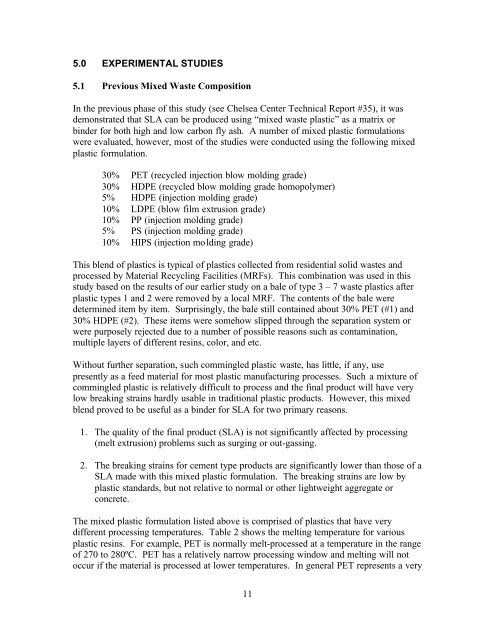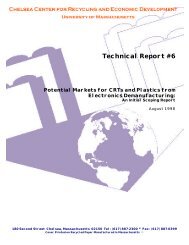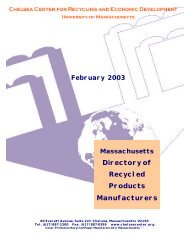fly ash/plastic synthetic aggregate for construction material
fly ash/plastic synthetic aggregate for construction material
fly ash/plastic synthetic aggregate for construction material
Create successful ePaper yourself
Turn your PDF publications into a flip-book with our unique Google optimized e-Paper software.
5.0 EXPERIMENTAL STUDIES<br />
5.1 Previous Mixed Waste Composition<br />
In the previous phase of this study (see Chelsea Center Technical Report #35), it was<br />
demonstrated that SLA can be produced using “mixed waste <strong>plastic</strong>” as a matrix or<br />
binder <strong>for</strong> both high and low carbon <strong>fly</strong> <strong>ash</strong>. A number of mixed <strong>plastic</strong> <strong>for</strong>mulations<br />
were evaluated, however, most of the studies were conducted using the following mixed<br />
<strong>plastic</strong> <strong>for</strong>mulation.<br />
30% PET (recycled injection blow molding grade)<br />
30% HDPE (recycled blow molding grade homopolymer)<br />
5% HDPE (injection molding grade)<br />
10% LDPE (blow film extrusion grade)<br />
10% PP (injection molding grade)<br />
5% PS (injection molding grade)<br />
10% HIPS (injection molding grade)<br />
This blend of <strong>plastic</strong>s is typical of <strong>plastic</strong>s collected from residential solid wastes and<br />
processed by Material Recycling Facilities (MRFs). This combination was used in this<br />
study based on the results of our earlier study on a bale of type 3 – 7 waste <strong>plastic</strong>s after<br />
<strong>plastic</strong> types 1 and 2 were removed by a local MRF. The contents of the bale were<br />
determined item by item. Surprisingly, the bale still contained about 30% PET (#1) and<br />
30% HDPE (#2). These items were somehow slipped through the separation system or<br />
were purposely rejected due to a number of possible reasons such as contamination,<br />
multiple layers of different resins, color, and etc.<br />
Without further separation, such commingled <strong>plastic</strong> waste, has little, if any, use<br />
presently as a feed <strong>material</strong> <strong>for</strong> most <strong>plastic</strong> manufacturing processes. Such a mixture of<br />
commingled <strong>plastic</strong> is relatively difficult to process and the final product will have very<br />
low breaking strains hardly usable in traditional <strong>plastic</strong> products. However, this mixed<br />
blend proved to be useful as a binder <strong>for</strong> SLA <strong>for</strong> two primary reasons.<br />
1. The quality of the final product (SLA) is not significantly affected by processing<br />
(melt extrusion) problems such as surging or out-gassing.<br />
2. The breaking strains <strong>for</strong> cement type products are significantly lower than those of a<br />
SLA made with this mixed <strong>plastic</strong> <strong>for</strong>mulation. The breaking strains are low by<br />
<strong>plastic</strong> standards, but not relative to normal or other lightweight <strong>aggregate</strong> or<br />
concrete.<br />
The mixed <strong>plastic</strong> <strong>for</strong>mulation listed above is comprised of <strong>plastic</strong>s that have very<br />
different processing temperatures. Table 2 shows the melting temperature <strong>for</strong> various<br />
<strong>plastic</strong> resins. For example, PET is normally melt-processed at a temperature in the range<br />
of 270 to 280ºC. PET has a relatively narrow processing window and melting will not<br />
occur if the <strong>material</strong> is processed at lower temperatures. In general PET represents a very<br />
11




